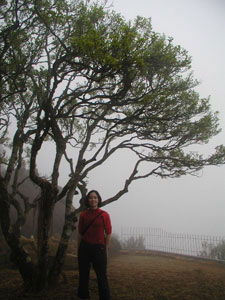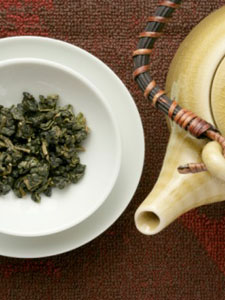Oolong: Hail the Black Dragon!
Ten years ago, the only contact that most people had with Oolong tea was in a local Chinese restaurant. Thankfully, as China has become more open to trade we can enjoy teas that used to be enjoyed exclusively by locals and government officials. In 1999, I tasted my first pot of High Mountain Oolong from Lishan, Taiwan and it was poignant enough to compel me to pursue a career in the world of tea. Fragrant like gardenias and naturally sweet, this compelling jade green Oolong became the personification of the tea experience that I wanted to share with the world.

If you thought oolong might be another type of green tea or just another thing to drink with your dim sum, I hope that you will be persuaded to embark on an exploration. Oolong literally translates to "black dragon". In Southern China, this phrase is a euphemism for a "happy mistake". The degree of oxidation is the defining characteristic that determines if the tea will be white, green, oolong, or black. The black dragon sits firmly in the center of this spectrum nestled between unoxidized green and fully oxidized black teas.

The treatment of tea leaves after harvest does not tell the whole story - it is merely the first chapter. Oolong is fully determined by region, varietal, leaf grade, shaping of the leaf and the degree of the roast. This style of tea is specific Fujian and Guangdong Provinces in China and throughout Taiwan. Certain varietals of the Camellia sinensis plants are specifically grown to be crafted into oolong teas; such as Green Heart and Red Heart. Each of these varietals flourishes in specific regions and each also lends itself best to either one, but rarely both methods of shaping the finished leaf. For example, Jinshuan is an oolong varietal grown in Jushan and Alishan in Taiwan. This style is always rolled in a pearl shape with the two to three leaves at the tip of the branch and finally lightly roasted. Never have I seen Jinshuan darkly roasted with a twisted leaf, because the leaf of the varietal is easier to roll than twist and best expresses it's sweet, sour nature when lightly roasted. The best Oolongs from China and Taiwan are picked in the late spring and late fall with the exception of the Formosa Beauty which is picked in late summer. The top two leaves at the end of the branches are the most desirable to harvest. Leaves should be pliable and whole, stems are generally avoided in best quality teas. The roasting process is a careful, time consuming procedure that can last from 8 to 36 hours without pause. Green Oolongs with twisted leaves such as Pouchong (also sometimes written as Baochong) take the least amount of time to make while dark roasted rolled leaves of Tikuanyin can take much longer to finish. This hands-on procedure of manipulating and roasting the leaves often takes years and sometimes generations to perfect.
Historically, Oolongs became popular by the Ming Dyasty (1400 AD) in China. The original Oolongs were long, dark roasted, twisted leaves from the Wuyi and Phoenix Mountains. Later Oolongs had a renaissance when Tikuanyin (Iron Goddess or Iron Bodhisattva) was introduced to one of China's most beloved emperor's Qian Lung (1735-1795) whose rule marked a 60 year period of prosperity and peace. Scholar Wong was aspiring for an appointment to office in the emperor's court. Afraid that he might not get the highest marks he hoped for on the exam, he made a batch of tea from a wild tea plant is his garden as a gift for the emperor. The emperor was greatly appreciative of the tea and is credited with the name Tikuanyin. He remarked that Scholar Wong's tea was "heavy in the hand like iron and beautiful like Kuanyin (the revered bodhisattva of compassion)". At this time, Tikuanyin style oolongs rolled and roasted into the shape of pearls spread in popularity. This style of rolled Oolongs was introduced to Taiwan in the Tung Ting (Cold Summit) mountains in 1850. Today, the best Oolongs continue to come from Fujian and Guangdong provinces in China and throughout Taiwan. Many new and interesting oolongs have also been produced in India and Nepal over the past decade.
Craftsmanship of this tea can be difficult to describe on paper, but when tasting these characteristics become readily apparent in the cup. One can taste the point of origin and technique of the tea master when tasting an oolong. Variations in the specific characteristics mentioned previously allow a broad spectrum of flavors and aromas. The end product is full-bodied, aromatic, and smooth cup of tea - a magnet for connoisseurs.
An introductory field guide to Oolong teas:
Formosa Beauty (Taiwan Beauty, Oriental Beauty, Bai Hao) - This summer oolong was originally produced Hsinchu County, Taiwan. This tea picked in the summer months is famous for it's beautiful silver tips and highly oxidized leaves. This tea is said to be a favorite of the Queen of England.
Pouchong (Baochong, Baozhong) - A blue green, lightly oxidized, twisted oolong from Wenshan in northern Taiwan prized for the delicate sweet taste, lilac like fragrance, and silky texture.
Tikuanyin (Tieguanyin, "Iron Goddess of Mercy", "Iron Bodhisattva") - Anxi County in Fujian, China is internationally recognized for producing the best Tikuanyin teas in the world. Some is also grown in Taiwan, but is not as well known as the Anxi Tikuanyin. Green, light roasted tikuanyins are distinctively floral. Those that have been roasted longer are less floral and reveal more amber fruit and honey notes.
Tung Ting (also Dong Ding, "Cold Summit") - The Tung Ting mountains in Central Taiwan produces many exceptional quality rolled Oolongs. Often when tasting these teas, one can discern a nutty and citrusy quality rarely found in Oolongs from other regions. When lightly roasted, floral notes remain prominent and in the forefront of the palate. As roasting time increases the nuttiness becomes more apparent.
Wuyi Oolongs - Fujian, China - This was one of the first regions to make oolong tea and is best known for the "rock teas" from wild tea trees which grow on the cliffs. Traditionally, these teas are twisted lengthwise then dark roasted.
Traditionally oolongs are prepared "gungfu" style or with great skill. Use 5 grams of leaves (a heaping teaspoon) per 8 oz of 180°F - 200°F water and steep one to two minutes. Use 180°F for green Oolongs and 190°F - 200°F for the dark roasted Oolongs. If you prefer stronger flavor, steep a bit longer to taste.
Check out Adagio Teas' selection of oolong teas
